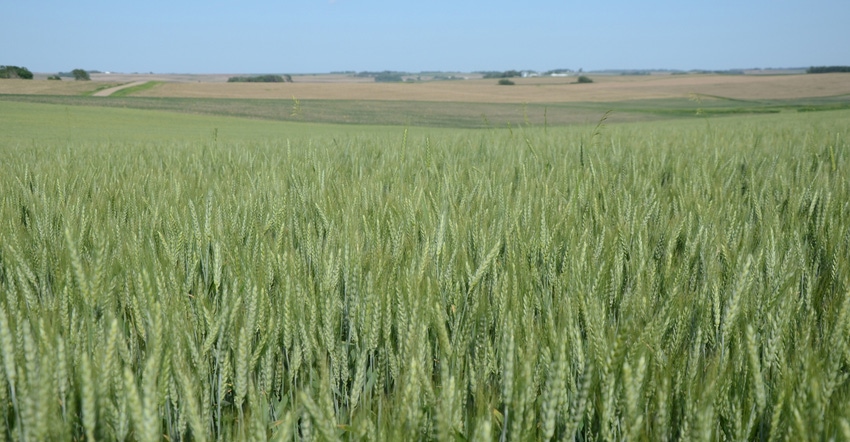
For those who grow winter wheat in eastern Nebraska, October is a month of scrambling — to get soybeans harvested and winter wheat seeded. This isn't just to meet best practices for yield potential, but also to meet USDA Risk Management Agency's cutoff date for full crop insurance of Oct. 15, and Oct. 30 for late-planted wheat in east-central and southeast Nebraska.
While winter wheat planted in late October or early November might not have the yield prospects of earlier-planted wheat, options exist, says Nathan Mueller, Nebraska Extension cropping systems educator in Dodge and Washington counties.
Mueller says he's seen decent yields by planting the third week of October — like those who planted late in 2017 and saw yields as high as 70 bushels per acre.
Just because a wheat crop is planted later, it doesn't mean it's a lost cause. "Planting date does have an impact, but if it's Oct. 31 or even Nov. 5, and you have unplanted seed, you might as well plant it. You don't have to make a decision to harvest that crop until spring," Mueller says. "We could get a warm November and warm December, and planting late may not be a big deal. But we may get a cold second half of November and December, and it could pose a problem for yield potential."
And Mueller notes the investment in fall fertility for a winter wheat cash crop isn't much compared to a winter wheat cover crop.
"The only application for wheat in the fall is MAP [monoammonium phosphate]. You're putting on phosphorus, and if it's ground you own, you're putting on a maintenance rate anyway. That's something you might already be doing before corn or soybeans," he says. "The nitrogen you're applying does help the wheat, and the wheat uses up excess nitrogen that might leach otherwise."
In this scenario, growers should closely evaluate final stands and tillering closely in March for yield potential. Mueller notes it's best to have 60 to 70 heads per square foot, although certain wheat varieties can put on more spikelets per head or larger seed than others.
Be flexible
To have the flexibility to choose a cash crop versus a cover or forage crop, growers need to have certified their wheat acres with the Farm Service Agency by Nov. 15. In the spring, a grower can change the use from grain to a cover crop with FSA. If the stand is less than ideal in the spring, Mueller says growers can always use the wheat crop as a cover crop — or, if they have cattle, as a forage crop.
"If you have livestock, there's always the option to graze it heavily in the spring before you spray it. So you have two different options," he says. "Down south they plant early and plant heavier, and they plan on grazing and still harvesting wheat as a cash crop. Here, if you're spring grazing, you're likely just using it as a forage crop you're going to plant corn-soybeans into."
Mueller often encourages growers to think about the value winter wheat brings to the rotation beyond cash value. The mindset here is to also think of winter wheat not just as a cash crop, but to be flexible in how winter wheat is used in the rotation.
"The idea is to think out these Plan B's, these flex options. If this year we didn't get winter wheat seeded until Nov. 5, what's our flex option? Do we want a cash, forage or cover crop?" Mueller says. "Everybody is so interested in cover crops, and wheat can be either-or. Winter wheat itself as a cash crop is really tied to the soil health no-till movement. The idea is to add flexibility to a system. I want people to have that mindset."
Making adjustments
For growers that are planting winter wheat late, and don't want to spend money on more seed, Mueller notes it's usually not a problem to increase the seeding rate and plant over a smaller area. Most winter wheat growers in eastern Nebraska typically plant a smaller number of acres — anywhere from 20 to 80 acres.
The question is: How much should you increase your seeding rate? New planting date and seeding rate research by Cody Creech, Nebraska Extension dryland cropping systems specialist, has some preliminary numbers available for wheat growers in western Nebraska.
While there are no new numbers specific to eastern Nebraska, Mueller says the older data being used for current recommendations in eastern Nebraska isn't too far off. Or growers can follow Kansas State University's recommendations for eastern Kansas. Mueller created a new Excel-based seeding rate adjustment tool for delayed planting based on current UNL recommendations for eastern Nebraska at croptechcafe.org/winterwheat.
"Part of what growers can do now in October, November, we know they do need to increase seeding rate to compensate for less tillers or heads per plant," Mueller says. "That's more problematic for us because we're not as close to as many certified seed growers, so even the retailers that carry wheat seed have to order it. That might require planting fewer acres if you can’t get extra seed quickly."
About the Author(s)
You May Also Like






